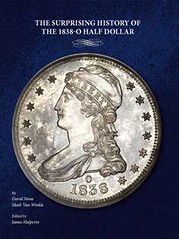
PREV ARTICLE
NEXT ARTICLE
FULL ISSUE
PREV FULL ISSUE
NEW BOOK: SURPRISING HISTORY OF THE 1838-O HALF DOLLAR
Heritage has published a nice monograph on the interesting history of the 1838-O Half Dollar. Here's the press release.
-Editor
The slight edition is rich in detail and historical depth, providing not only a compelling read but securing a place for itself among collectors as an indispensible research tool. It can be purchased online by emailing catalogorders@ha.com. "Despite its long history, and the high prices examples have realized at public auction," said Halperin, "there have always been many questions about the origin and purpose of the 1838-O, since the coins were not mentioned in the official New Orleans Mint report for 1838. This study sheds some light on the surprising history of these important coins." 1838-O Halves have been avidly collected since the mid-19th century. In fact, the specimen in the Smithsonian Institution was one of the earliest donations to the National Numismatic Collection, which originated as the Mint Cabinet in 1838. "New evidence indicates 1838-O half dollars were struck on two different occasions," said Halperin. "Originals were struck early in 1838 at the Philadelphia Mint as prototypes for a planned New Orleans Mint coinage that never took place due to production difficulties in that facility's first year of operations." The Philadelphia coins display proof surfaces, with sharply detailed design elements and no evidence of die rust or doubling of devices. Restrikes, however, were struck in January 1839 in New Orleans, to test a new coining press because the 1839-dated dies had not been shipped from the Philadelphia Mint at that time. "These coins show clear evidence of die rust and profound doubling on some letters and devices," added Halperin, "probably caused by unorthodox placement of the dies in the coining press. The rusted dies indicate that some time passed between the two strikings and the doubling suggests the dies were not secured in the same fashion, causing the dies to bounce when the coins were struck." The booklet goes into detail about letters found in the National Archives – discovered by R.W. Julian – that outline many of the difficulties encountered by the staff of the New Orleans Mint in 1838, including a first-person account of the New Orleans striking. Chief Coiner Rufus Tyler wrote to Mint Director Robert M. Patterson, on February 25, 1839, informing him that 10 examples of the 1838-O had recently been coined. After that, Tyler presented one of the coins to his old college professor, Dr. Alexander Bache, along with a note stating "not more than twenty pieces were struck with the half dollar dies of 1838." The discrepancy between the two mintage figures suggests that Tyler was aware of two different coining events, the 10 coins he struck early in 1839 and the earlier Philadelphia striking in 1838. More evidence about the Philadelphia striking has come to light through a study of 19th century auction descriptions and periodicals. "We expect the newly discovered dual origin of the 1838-O half dollar to change the way numismatists think about this important coin," said Halperin.
In addition, this paper features major revisions to recent rosters, where findings show only nine specimens of the 1838-O are still extant, instead of the usually listed 11 coins. Images of all known specimens are included, with the individual pedigree of each coin.
The Numismatic Bibliomania Society is a non-profit organization promoting numismatic literature. See our web site at coinbooks.org. To submit items for publication in The E-Sylum, write to the Editor at this address: whomren@gmail.com To subscribe go to: https://my.binhost.com/lists/listinfo/esylum All Rights Reserved. NBS Home Page Contact the NBS webmaster 
|
